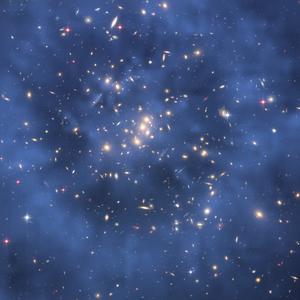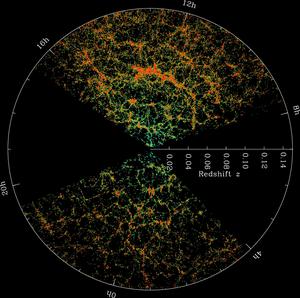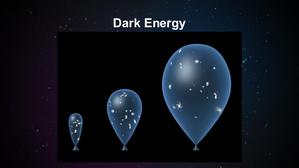Glossary term: 暗物質
Description: 暗物質是一種假設中的物質形式,它具有質量,但完全透明,且不發光。它作為與各種引力相互作用有關現象的聯合解釋被提出。
早期關於暗物質存在的證據來自於星系團中高速運動的星系。假設存在額外的質量有助於解釋為什麼這些星系的運動速度很快,卻仍然被引力束縛在所屬的星系團內,而沒有逃逸出去。維拉·魯賓(Vera Rubin)等人對盤狀星系中恆星和氣體軌道速度的測量推動了暗物質概念的廣泛接受:根據引力定律,要想解釋觀測到的高轉動速度,除了可見物質之外,還需要有相當大質量的物質。最近,引力透鏡觀測也顯示星系團中存在大量不發光物質。
在宇宙學中,宇宙膨脹歷史表明,宇宙中存在的物質比可見物質要多。早期宇宙結構形成的常見解釋也依賴於暗物質的存在。基於這些原因,標準宇宙學模型被稱為”Lambda CDM模型“,其中CDM代表冷暗物質(即速度慢的暗物質)。
暗物質的本質是宇宙學和粒子物理學中研究和討論的熱點話題。暗物質的有關證據仍然是間接的,主要依賴於觀測暗物質質量對發光物質或光的影響。有幾種尚未被檢測到的基本粒子被提出作為暗物質的可能組成部分,但專門用於尋找這些候選粒子的實驗到目前為止都未能取得成功。也有一些替代性的解釋被提出,聲稱可以在不涉及新粒子的情況下解釋相關觀測結果。
Related Terms:
See this term in other languages
Term and definition status: The original definition of this term in English have been approved by a research astronomer and a teacher The translation of this term and its definition is still awaiting approval
This is an automated transliteration of the simplified Chinese translation of this term
The OAE Multilingual Glossary is a project of the IAU Office of Astronomy for Education (OAE) in collaboration with the IAU Office of Astronomy Outreach (OAO). The terms and definitions were chosen, written and reviewed by a collective effort from the OAE, the OAE Centers and Nodes, the OAE National Astronomy Education Coordinators (NAECs) and other volunteers. You can find a full list of credits here. All glossary terms and their definitions are released under a Creative Commons CC BY-4.0 license and should be credited to "IAU OAE".
If you notice a factual or translation error in this glossary term or definition then please get in touch.
Related Media
暗物質
Credit: 美國國家航空航天局、歐空局、M.J. Jee 和 H. Ford(約翰霍普金斯大學) credit link
License: CC-BY-4.0 Creative Commons 姓名標示 4.0 國際 (CC BY 4.0) icons
SDSS 紅移分布圖
Credit: M.布蘭頓和斯隆數字巡天 credit link
License: CC-BY-4.0 Creative Commons 姓名標示 4.0 國際 (CC BY 4.0) icons
Related Activities
Dark matter & dark energy (Part 2) – Understanding the nature of dark matter and dark energy
astroEDU educational activity (links to astroEDU website) Description: Let's investigate the nature of dark matter and energy with gravitational lensing!
License: CC-BY-4.0 Creative Commons 姓名標示 4.0 國際 (CC BY 4.0) icons
Tags:
Experiment
, Invisible
Age Ranges:
12-14
, 14-16
, 16-19
, 19+
Education Level:
Informal
, Middle School
Areas of Learning:
Guided-discovery learning
, Interactive Lecture
, Modelling
, Problem-solving
Costs:
Medium Cost
Duration:
45 mins
Group Size:
Group
Skills:
Constructing explanations
, Developing and using models
, Engaging in argument from evidence
Dark matter and Dark energy (Part 1) – Discovering the main components of the Universe
astroEDU educational activity (links to astroEDU website) Description: Lets' investigate gravity, dark matter and dark energy with some very simple experiments!
License: CC-BY-4.0 Creative Commons 姓名標示 4.0 國際 (CC BY 4.0) icons
Tags:
Experiment
, Galaxies
Age Ranges:
12-14
, 14-16
, 16-19
, 19+
Education Level:
Informal
, Middle School
Areas of Learning:
Guided-discovery learning
, Interactive Lecture
, Modelling
, Observation based
, Other
, Problem-solving
Costs:
Low Cost
Duration:
45 mins
Group Size:
Group
Skills:
Constructing explanations
, Developing and using models
, Engaging in argument from evidence
, Planning and carrying out investigations












